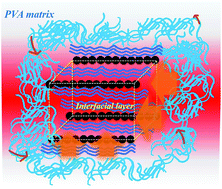The stiffness–thermal conduction relationship at the composite interface: the effect of particle alignment on the long-range confinement of polymer chains monitored by scanning thermal microscopy
Abstract
The polymer/filler interface is usually considered as a thermal barrier in composites due to the mismatch of the phonon frequency across the interface. How the interface plays its role in thermal conduction has not yet been fully understood. In this work, scanning thermal microscopy is used to map the probe current across the composite interface and force–displacement curves are obtained to assess the polymer stiffness. The microscale stiffness–thermal conduction relationship is investigated at the composite interface in three representative cases: a single aggregated particle domain, two neighboring particle domains and two parallelly aligned particle chains. In the studied poly(vinyl alcohol) (PVA)/Fe3O4 composites, it is revealed that the interface property dominates the thermal conduction behavior rather than particle percolation. The long range order of polymer chains surrounding the particle domains is responsible for the enhanced crystallinity and thermal conductivity of the composites. With magnetic alignment of Fe3O4 particles, PVA crystallinity and thermal conductivity can be further enhanced. The macroscopic thermal conductivity measurement is highly consistent with the microscale observation. Specifically, with only 2.3 vol% loading of Fe3O4 in PVA, the thermal conductivity can be increased by 56% to 0.42 W m−1 K−1. By the magnetic alignment of the particles at the same loading, 133% enhancement of thermal conductivity (∼0.63 W m−1 K−1) can be achieved. This work presents an experimental study on the exploration of the interface property–thermal conductivity relationship in differently structured micro-domains and reveals the positive role of the composite interface in thermal conduction.



 Please wait while we load your content...
Please wait while we load your content...